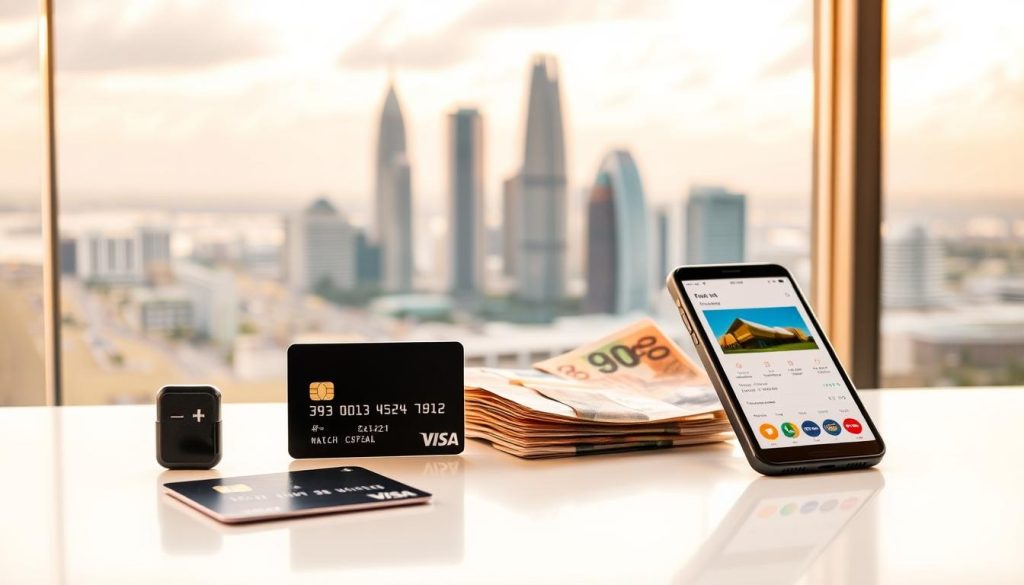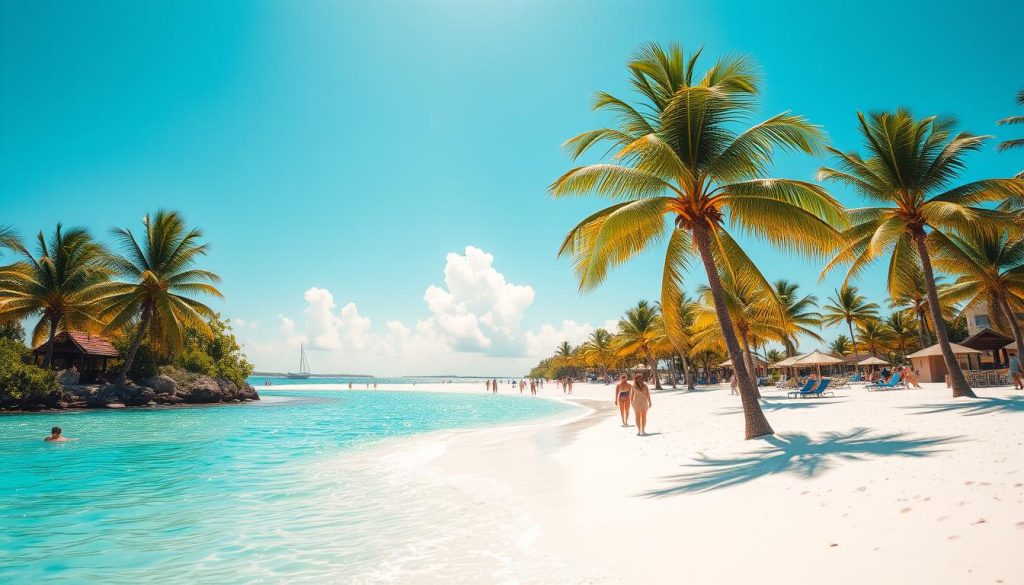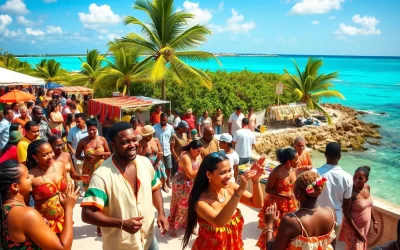✓ Accommodations✓ Flights✓ Rental Cars✓ Tours & Activities
Did you know that over 1.5 million visitors explore the stunning islands of Turks and Caicos each year? This tropical paradise is a dream destination for many, but planning your trip involves more than just packing sunscreen. Understanding the local currency and payment options is key to a smooth and enjoyable vacation.
In Turks and Caicos, the U.S. dollar is the official currency, making it easy for travelers from the United States. Whether you’re dining at a beachside café or shopping for souvenirs, you’ll find that both cash and card payments are widely accepted. However, some smaller vendors may prefer cash, so it’s wise to carry a mix of both.
This guide will walk you through everything you need to know about managing your money during your visit Turks Caicos. From understanding local tipping customs to navigating digital payment solutions, we’ve got you covered. Let’s dive in and ensure your trip is as seamless as the crystal-clear waters of this Caribbean gem.
Welcome to Turks & Caicos: An Island Paradise
Imagine stepping onto soft white sands with crystal-clear waters stretching as far as the eye can see. This is the magic of Turks and Caicos, a destination that combines natural beauty with a relaxed yet vibrant vibe. Whether you’re lounging on the beach or exploring local spots, every moment here feels like a dream.
Discover the Natural Beauty and Unique Vibes
Grace Bay is the crown jewel of the islands, offering 12 miles of pristine shoreline. The turquoise water is perfect for swimming, snorkeling, or simply soaking in the view. Beyond the beach, you’ll find a lively atmosphere with charming restaurants serving fresh seafood, including the famous conch dishes.
For a deeper dive into island life, visit the local fish markets or take a ferry to explore nearby cays. Each spot has its own charm, from secluded beaches to bustling harbors. Don’t forget your camera—these scenic views are unforgettable.
What Makes Turks & Caicos a Must-Visit Destination
What sets this place apart is its unique blend of relaxation and adventure. You can spend your days lounging on the beach or diving into the vibrant underwater world. The islands are also home to diverse dining options, from casual beachside cafes to upscale restaurants.
Getting around is easy with local transportation options like rental cars and taxis. Whether you’re driving along the coast or hopping on a ferry, every journey offers a new perspective on this tropical paradise. It’s no wonder Turks and Caicos is a top destination for travelers seeking both tranquility and excitement.
Getting Started: Entry Requirements & Travel Essentials
Planning your travel to this tropical destination starts with understanding entry requirements. Whether you’re arriving for a short getaway or an extended stay, knowing the essentials ensures a smooth journey. Let’s break down what you need to prepare before you go.
COVID-19 Protocols and Vaccination Guidelines
To enter, you must be fully vaccinated. This means being 14 days past your second dose of a WHO-approved vaccine or the single dose of the Janssen/Johnson & Johnson vaccine. While PCR tests are no longer mandatory, it’s still wise to check for updates before your flight.
Make sure to gather and print all relevant documents, including your vaccination certificate. Efficient testing centers like Seven Stars Resort & Spa can assist if needed. Staying informed about the latest guidelines will save you time and stress.
Travel Insurance and Visa Considerations
Travel insurance is a must. It covers medical expenses, hospitalizations, and even unexpected events like natural disasters. For example, the Atlas Travel plan offers up to $1,500 for emergency accommodations and $25,000 for personal liability.
If you’re from the USA, Canada, or the UK, you won’t need a visa. However, it’s always good to double-check your eligibility. Budgeting for meals, car rentals, and accommodations will also make your trip more enjoyable.

Most international flights land at Providenciales International Airport. Navigating the airport is straightforward, but having your documents ready will speed up the process. From here, you’re just a short ride away from your dream destination.
Understanding Currency Basics in Turks & Caicos
Managing your money wisely is a key part of any trip. In this tropical destination, the U.S. dollar is the official currency. This makes it simple for travelers from the United States to handle transactions without worrying about exchange rates.
Using the U.S. Dollar Effectively
Carrying small bills is a smart move. Many local vendors prefer cash and may not have change for larger denominations. This is especially true at smaller shops or markets. Having smaller bills ensures smooth transactions and saves you time.
Cash and Card Acceptance Across the Islands
While most hotels and restaurants accept card payments, some smaller businesses may only take cash. Taxis, for example, often prefer cash. It’s a good idea to carry both payment methods to avoid inconvenience.
Here’s a quick breakdown of where cash and cards are commonly accepted:
| Location | Cash Acceptance | Card Acceptance |
|---|---|---|
| Hotels | Yes | Yes |
| Restaurants | Yes | Yes |
| Local Markets | Yes | Limited |
| Taxis | Yes | Rarely |
Planning ahead with your currency needs ensures a hassle-free experience. Whether you’re renting a car or dining out, being prepared makes all the difference.
Turks & Caicos: Ultimate Travelers Guide to Currencies & Payments
When exploring a new destination, knowing how to handle payments can make your experience smoother. In this tropical paradise, you’ll find a mix of traditional and modern payment options. From cash to digital solutions, being prepared ensures you can focus on enjoying your trip.

Modern and Traditional Payment Options
Most hotels and upscale restaurants accept credit and debit cards. Visa and Mastercard are widely used, while American Express is less common. For smaller vendors or local markets, cash is often preferred. Carrying small bills ensures smooth transactions.
Digital payment methods like Apple Pay and Google Pay are gaining popularity. However, not all businesses support these options. It’s a good idea to have a backup plan, especially in remote areas.
Best Practices for Safe Payments
Here are some tips to ensure your payments are secure and hassle-free:
- Notify your bank about your travel dates to avoid card blocks.
- Carry a mix of cash and cards for flexibility.
- Use ATMs in well-lit, secure locations to withdraw local currency.
- Keep an eye on your card during transactions to prevent skimming.
For example, at popular beachside cafes, cards are usually accepted. But if you’re visiting a local fish market, cash is the way to go. Planning ahead saves you from unexpected challenges.
Preparing for Offline Card Processing
In some areas, card machines may not work due to connectivity issues. Always carry enough cash for emergencies. This is especially important when hiring taxis or shopping at smaller stores.
By following these best practices, you can manage your payments seamlessly. Whether you’re dining out or exploring local markets, being prepared ensures a stress-free experience.
Navigating Foreign Exchange and ATM Challenges
Accessing cash and managing foreign exchange can be tricky in remote island destinations. While Providenciales has plenty of ATMs, outlying islands like Grand Turk and Salt Cay offer very few or none at all. Planning your cash needs in advance ensures you avoid delays or long bank queues.
Where to Find Reliable ATMs
Most ATMs are concentrated in Providenciales, especially near the airport and popular resort areas. However, if you’re visiting Grand Turk or Salt Cay, ATMs are limited and often unreliable. It’s wise to withdraw enough cash before heading to these islands.
Here’s a quick tip: Use ATMs attached to banks for better rates and lower fees. Independent operators may charge higher transaction costs. Always check for hidden fees before withdrawing.
Tips for Handling Currency Exchange Hassles
Currency exchange can be a hassle if you’re not prepared. Compare withdrawal fees and use local banks for better rates. Avoid airport kiosks, as they often offer less competitive rates and higher fees.
If you’re traveling between islands, consider ferry and flight schedules. Limited banking hours and connectivity issues can impact access to services. Carrying extra cash ensures you’re covered in case of emergencies.
By planning in advance and following these tips, you can navigate foreign exchange and ATM challenges with ease. This way, you’ll spend less time worrying about cash and more time enjoying your trip.
Embracing Digital Payments and Contactless Solutions
Digital payments are transforming how we handle transactions, even in tropical destinations. Across the islands, you’ll find an increasing acceptance of contactless technologies, making your travel experience smoother and more convenient.

Mobile Payment Options Like Apple Pay and Google Pay
Mobile payment options like Apple Pay and Google Pay are gaining popularity. Many local vendors, including popular restaurants and resort shops, now accept these convenient methods. For example, beachside cafes and tour operators often support these card-free solutions.
However, it’s important to note that connectivity issues can sometimes arise. Always carry a backup cash option to avoid inconvenience, especially in remote areas or when visiting local fish markets.
Streamlining Transactions with Digital Payments
Digital payments simplify transactions, especially when booking tours or dining at popular spots. They save time and reduce the need to carry large amounts of cash. Here’s a quick overview of where digital payments are commonly accepted:
| Location | Apple Pay | Google Pay |
|---|---|---|
| Hotels | Yes | Yes |
| Restaurants | Yes | Yes |
| Tour Operators | Limited | Limited |
| Local Markets | Rarely | Rarely |
Using these digital solutions enhances your overall service experience. Whether you’re renting a car or exploring the islands, embracing these technologies ensures a hassle-free trip.
Local Taxes, Fees, and Tipping Practices
Understanding local taxes and tipping customs can make your trip more enjoyable. While the islands are known for their stunning beaches, knowing how to handle these financial aspects ensures a stress-free experience.
Understanding Tourist Taxes and Service Charges
When staying at a hotel, you’ll notice a 12% Hotel and Tourism Tax added to your bill. This is mandatory and applies to most accommodations. Some places may also include a 5% Facility Fee, which is not government-imposed but still affects your total cost.
At restaurants, a service charge of up to 10% might be included in your bill. Always check your receipt to avoid double-tipping. These fees help support the local economy but can add up, so it’s good to budget accordingly.
How to Tip Appropriately for Exceptional Service
Tipping is a big part of the culture here. For most service jobs, like waiters or taxi drivers, a 15-18% tip is standard. If a service charge is already included, consider adding an extra 5% to show appreciation for exceptional service.
Here’s a quick guide to tipping in different scenarios:
- Restaurants: 15-18% if no service charge is included.
- Hotels: $1-2 per bag for porters, $2-5 per day for housekeeping.
- Tours: 10-25% depending on the experience, with $20 per person for shared charters.
By following these guidelines, you’ll ensure your day-to-day interactions are smooth and appreciated. Whether you’re enjoying fresh conch or exploring the islands, tipping appropriately is a thoughtful option.
Optimizing Your Travel Budget in Turks & Caicos
Making the most of your trip to this tropical paradise starts with smart budgeting. While the islands offer unforgettable experiences, managing your expenses ensures you enjoy every moment without overspending. Here’s how to balance luxury and savings during your vacation.
Budgeting for High-End Food and Activities
Dining at upscale restaurants is a highlight of any trip, but it can quickly add up. To save, consider alternating high-end meals with more affordable options. For example, enjoy a lavish dinner one night and opt for local street food the next. This way, you get the best of both worlds without breaking the bank.
When planning your day, prioritize must-do activities like snorkeling or island tours. Water sports can cost between $50-$150 per person, so schedule these early in your trip. Off-peak timings often offer better deals, so check for discounts or group rates.
Strategies for Cost-Effective Exploration
Gathering price information beforehand is a smart move. Many resorts and tour operators list their rates online, so compare options to find the best value. Booking in advance can also save you time and money, especially during peak seasons.
Here are some tips to stretch your budget further:
- Pack snacks and drinks to avoid overpriced convenience store purchases.
- Use public beaches for free access to stunning views and relaxation.
- Consider all-inclusive packages for meals and activities bundled at a lower cost.
By planning ahead and making smart choices, you can enjoy every thing this destination has to offer without overspending. Whether it’s a luxurious meal or an exciting tour, balancing your expenses ensures a stress-free and memorable trip.
Choosing Accommodations and Transportation Options
Finding the perfect place to stay and the best way to get around can make or break your trip. Whether you’re looking for luxury or affordability, understanding your options ensures a smooth and enjoyable experience.
Luxury Resorts vs. Affordable Alternatives
If you’re dreaming of a lavish stay, Grace Bay offers stunning resorts with ocean views and top-notch amenities. These hotels often include pools, spas, and beachfront access, making them ideal for a relaxing getaway.
For those on a budget, there are plenty of affordable accommodation options. Guesthouses and vacation rentals provide comfort without the high price tag. Many are located near popular attractions, giving you easy access to the best the islands have to offer.
Here’s a quick comparison of luxury and budget-friendly stays:
| Type | Features | Average Cost Per Night |
|---|---|---|
| Luxury Resort | Private beach, spa, fine dining | $500+ |
| Budget Guesthouse | Comfortable rooms, shared facilities | $150-$250 |
Why Renting a Car is Essential
Getting around the islands is much easier with a rental car. Taxis can be expensive, especially for longer distances. Renting a car gives you the freedom to explore at your own pace and saves you time.
Car rental prices start at around $50 per day, with additional fees for insurance and government surcharges. Compare this to taxi fares, which can cost $20-$30 for a short ride. Having your own vehicle also allows you to visit remote beaches and hidden gems.
When picking up your car at Providenciales International Airport, check for any damage and confirm the fuel policy. Most rentals require a full tank upon return.
Here are some tips for renting a car:
- Book in advance to secure the best rates.
- Check for discounts through your hotel or tour operator.
- Drive on the left side of the road, as is the local custom.
By choosing the right accommodation and transportation, you can make the most of your trip. Whether you’re staying in a luxury resort or exploring the islands by car, planning ahead ensures a stress-free experience.
Island Experiences: Beaches, Attractions, and Adventure Highlights
From pristine beaches to thrilling water sports, there’s something for everyone to enjoy. The islands are a paradise for those seeking both relaxation and adventure. Whether you’re lounging on the sand or diving into the vibrant underwater world, every moment here is unforgettable.
Top Beaches and Water Sports to Try
Grace Bay is a must-visit spot, often ranked among the world’s best beaches. Its turquoise waters and soft white sand make it perfect for swimming or simply soaking in the view. For more excitement, try snorkeling or jet skiing. These activities let you explore the island’s rich marine life up close.

If you’re looking for a quieter place, Taylor Bay Beach offers shallow, calm waters ideal for families. Sapodilla Bay is another hidden gem, known for its stunning sunsets. Both spots are perfect for a relaxing day by the water.
Exploring Island Tours and Local Excursions
Island tours are a great way to see the best of what the islands have to offer. Popular options include snorkeling trips to coral reefs and bird-watching tours. These activities give you a chance to connect with nature and capture breathtaking views.
In Grand Turk, don’t miss the chance to visit the historic lighthouse or explore the local fish markets. Salt Cay offers a more laid-back vibe, with opportunities for whale watching during the migration season. Both islands provide unique experiences that add depth to your trip.
| Activity | Location | Best Time |
|---|---|---|
| Snorkeling | Grace Bay | Morning |
| Jet Skiing | Long Beach | Afternoon |
| Bird-Watching | Grand Turk | Early Evening |
Planning your day is key to making the most of your time. Start with a morning water activity, enjoy lunch at a local restaurant, and end with a relaxing evening tour. This balance ensures you experience both adventure and tranquility.
Cultural Immersion and Local Delights
Dive into the heart of island culture and discover the vibrant traditions that make this destination unforgettable. From mouthwatering dishes to lively festivals, there’s something for everyone to enjoy. Let’s explore the best ways to connect with the local community and savor the unique flavors of this tropical paradise.
The Vibrant Food Scene and Must-Try Local Dishes
The culinary world here is a feast for the senses. Upscale restaurants offer gourmet meals with stunning ocean views, while local eateries serve authentic Caribbean flavors. One dish you can’t miss is conch, a local delicacy prepared in various ways—grilled, fried, or in a refreshing salad.
For a more casual spot, try the weekly fish fry events. These gatherings are a great way to enjoy fresh seafood while mingling with locals. Don’t forget to pair your meal with a tropical drink for the full experience.
Here are some must-try dishes:
- Conch Fritters: Crispy and flavorful, perfect as a snack.
- Grilled Lobster: Freshly caught and seasoned to perfection.
- Peas and Rice: A staple side dish with a Caribbean twist.
Festivals, Art, and Community Events
Immerse yourself in the local culture by attending festivals and art events. These gatherings showcase the island’s rich heritage and provide a unique view into its traditions. From music festivals to craft markets, there’s always something happening.
One highlight is the annual Cultural Festival, where you can enjoy live performances, traditional dances, and handmade crafts. It’s a great place to pick up souvenirs and support local artisans.
For art lovers, curated tours take you to galleries and cultural museums. These experiences offer a deeper understanding of the island’s history and creative world. Whether you’re a tourist or a returning visitor, these events are a must-see.
Here’s how to make the most of your time:
- Check local event calendars for upcoming festivals.
- Join guided tours that include visits to cultural sites.
- Engage with locals to learn more about their traditions.
By incorporating these cultural experiences into your itinerary, you’ll create memories that last a lifetime. Whether it’s savoring a delicious meal or dancing at a festival, every moment here is a celebration of island life.
Safety Tips and Travel Warnings
Staying safe while managing your money is a top priority during any trip. Whether you’re withdrawing cash or exploring new places, being cautious ensures a smooth experience. Here’s how to protect yourself and your finances.
Maintaining Safety While Withdrawing Cash
Using ATMs during the day is the safest way to handle cash withdrawals. Avoid late night transactions, as they can attract unwanted attention. Always choose ATMs in well-lit, secure locations, such as inside banks or busy areas.
Past travelers have reported incidents like armed robberies and muggings, especially in less crowded spots. To minimize risk, plan your cash needs early in the day. This way, you won’t need to search for ATMs after dark.
- Notify your bank about your travel dates to avoid card blocks.
- Carry only the cash you need for the day to reduce loss in case of theft.
- Use secure banking apps for transfers instead of carrying large amounts of cash.
When using a car, keep your valuables out of sight. Lock your doors and avoid leaving cash or wallets on the seats. These small steps can make a big difference in keeping your belongings safe.
If you’re on a tour, stay alert and follow your guide’s instructions. Avoid displaying expensive items or large sums of cash. Being mindful of your surroundings is the best thing you can do to stay safe.
Conclusion
Exploring a tropical paradise requires careful planning and practical insights. From understanding entry requirements to mastering local payment methods, this guide has equipped you with everything you need for a seamless trip. Whether you’re budgeting for high-end restaurants or navigating transportation options, these tips ensure you make the most of your time.
Remember, the U.S. dollar is widely accepted, but carrying cash is essential for smaller vendors. Digital payments are convenient, yet having a backup plan is wise. With stunning views and world-class service, this destination offers an unforgettable experience.
As you prepare for your next flight, revisit this guide to ensure a smooth journey. From hotel stays to car rentals, every detail matters. Embrace the beauty of this place and create memories that last a lifetime.
The above is subject to change.
Check back often to TRAVEL.COM for the latest travel tips and deals.






